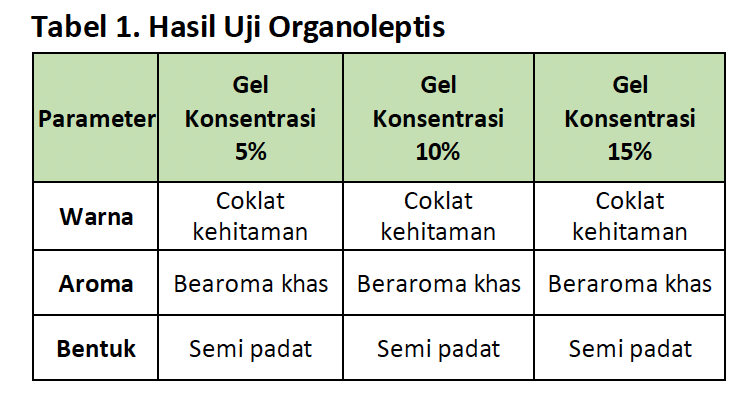Activity Test of Hand Sanitizer With Ethanol Extract of Euphorbia milli Leaves against Staphylococcus epidermidis Bacteria
DOI:
https://doi.org/10.36733/usadha.v3i2.7435Keywords:
Antibacterial, Euphorbia milli, Staphylococcus epidermidisAbstract
Euphorbia milli is a plant that has medicinal properties, one of which is that Euphorbia milli leaves contain peroxidase, saponins, calcium oxalate, peptic substances, and starch. Meanwhile, the sap contains euphorbol, euphol, and cyoartenol. The leaves are widely used as a remedy for boils (furuncle), purulent inflammation of the skin (piodermi), scalds, and burns. Euphorbia milli folia leaves contain saponins, which have potential as antibacterials. This study aims to determine the antibacterial activity of the ethanol extract of the giwang fern cactus leaves on the growth of Staphylococcus epidermidis by making a hand sanitizer gel from the giwang fern cactus leaf extract using three variations of extract concentrations: 5%, 10%, and 15%. The plant extracts were obtained using the maceration method using 70% ethanol with three replications. This research method is laboratory-experimental research. The results showed that the hand sanitizer gel had an inhibitory effect on the growth of the Staphylococcus epidermidis bacteria.
References
Fatmawati, Fenti. Edukasi Penggunaan Hand Sanitizer dan Pembagian Hand Sanitizer Disaat Pandemi COVID-19. JCES [Internet]. 2020 [cited: 2023]: 3(2). Available from: https://journal.ummat.ac.id/index.php/JCES /article/view/2401
H. B. Aviany, and S. Pujiyanto. Analisis Efektivitas Probiotik di dalam Produk Kecantikan sebagai Antibakteri terhadap Bakteri Staphylococcus epidermidis. Berkala Bioteknologi [Internet]: 2020 [cited: 2023]: 3 (2). Available from: https://ejournal2.undip.ac.id/index.php/bb/ article/view/9657
Suherman, B., and Isnaeni, D. The Formulasi Sediaan Salep Ekstrak Daun Kaktus Pakis Giwang (Euphorbia milii Ch. Des Moulins) Kombinasi Basis Modifikasi PEG 4000 Dan PEG 400 serta Aktivitas Antibakteri Terhadap Staphylococcus epidermis. Jurnal Herbal Indonesia [Internet]. 2019 [cited:2023]: 1(1): 18-32. Available from: https://uit.e- journal.id/JHI/article/view/628
Novitasari, Anik Eko, and Dinda Zahrina Putri. Isolasi dan Identifikasi Saponin pada Ekstrak Daun Mahkotadewa dengan Ekstraksi Maserasi. Jurnal Sains [Internet]. 2016 [cited: 2023]: 6 (12): 10-14. Available from: http://journal.unigres.ac.id/index.php/Sains /article/view/577/450
Ngajow, Mercy Ngajow., Jemmy Abidjulu., and Vanda S. Kamu. Pengaruh Antibakteri Ekstrak Kulit Batang Matoa (Pometia pinnata) terhadap Bakteri Staphylococcus aureus secara In vitro. JURNAL MIPA UNSRAT [Internet]. 2013 [cited: 2023]: 2(2): 128-132. Available from: https://ejournal.unsrat.ac.id/v3/index.php/j muo/article/view/3121/2665
Maimunah, Siti., Rayhana Rayhana., Yosy Cinthya Eriwaty Silalahi. Aktivitas Antibakteri Ekstrak Daun Jeruk Purut (Citrus hystrix DC) Terhadap Bakteri Staphylococcus aureus. Jurnal Nukleus [Internet]. 2020 [cited: 2023]: 6 (2). Available from: https://jurnal.ulb.ac.id/index.php/nukleus/a rticle/view/1767
Asri Rahmiati, Asri., Sri Darmawati., Ana Hidayati Mukaromah. Daya Hambat Ektrak Etanol Buah Belimbing Wuluh (Averrhoa bilimbi L) Terhadap Pertumbuhan Staphylococcus Aureus Dan Staphylococcus
Epidermidis Secara In Vitro. Prosiding [Internet]. 2017 [cited: 2023]. Available from: https://jurnal.unimus.ac.id/index.php/psn1 2012010/article/view/2957

Downloads
Published
Issue
Section
License
Copyright (c) 2024 Penulis

This work is licensed under a Creative Commons Attribution-NonCommercial 4.0 International License.




